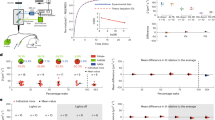Abstract
IN clinical and experimental epilepsy, transient fluctuations in susceptibility to seizures have been shown to result from changes in behavioural state. For example, spontaneous electro-encephalographic (EEG) and overt behavioural signs of seizures have been reported more frequently during periods of relaxtion or sleep than during periods of alertness or arousal in epileptic patients1,2. Furthermore, sensory stimuli that produce alerting and orienting responses also interrupt seizure activity in patients3–5 and in animals with various types of experimental epilepsy6–11. In addition, seizures produced in cats by subcortical application of aluminum oxide12 or systemic injection of metrazol13 have been interrupted by electrical stimulation of the mesencephalic reticular formation, a neural network believed to underlie behavioural and EEG arousal14.
This is a preview of subscription content, access via your institution
Access options
Subscribe to this journal
Receive 51 print issues and online access
$199.00 per year
only $3.90 per issue
Buy this article
- Purchase on Springer Link
- Instant access to full article PDF
Prices may be subject to local taxes which are calculated during checkout
Similar content being viewed by others
References
Gibbs, E. L., and Gibbs, T. A., A. Res. Nerv. Ment. Dis. Proc., 26, 366 (1947).
Servit, Z., Machek, J., and Stercova, A., in Reflex Mechanisms in the Genesis of Epilepsy (edit. by Servit, Z.) (Elsevier, Amsterdam, 1963).
Efrom, R., Brain, 79, 256 (1956).
Henner, K., in Reflex Mechanisms in the Genesis of Epilepsy (edit. by Servit, Z.) (Elsevier, Amsterdam, 1963).
Jung, R., in Reflex Mechanisms in the Genesis of Epilepsy (edit. by Servit, Z.) (Elsevier, Amsterdam, 1963).
Guerrero-Figueroa, R., Barros, A., Lester, B., and Heath, R. G., Acta Neurol. Latinoamer., 12, 6 (1966).
Atzev, E. S., in Reflex Mechanisms in the Genesis of Epilepsy (edit. by Servit, Z.) (Elsevier, Amsterdam, 1963).
Lairy-Bounes, G. C., Parma, M., and Zanchetti, A., EEG Clin. Neurophysiol., 4, 495 (1952).
Bures, J., Physiologia Bohemoslovenica, 2, 19 (1953).
Lindsley, D. B., Finger, F. W., and Henry, C. E., J. Neurophysiol., 5, 185 (1943).
Pinel, J. P. J., Communication in Behavioural Biology (in the press).
Guerrero-Figueroa, R., Barros, A., and De Balbain Verster, F., Epilepsia, 4, 225 (1963).
Fernandez-Guardiola, A., Alcaraz, M., and Guzman, C., Acta Neurol. Latinoamer., 7, 30 (1961).
Lindsley, D. B., Schreiner, L. H., Knowles, W. B., and Magoun, H. W., EEG Clin. Neurophysiol., 2, 483 (1950).
Pradhan, S. N., and Ajmone Marsan, C., Epilepsia, 4, 1 (1963).
Mirsky, A. F., Bloch-Rojas, S., and McNary, W. F., Acta Biol. Exp., 26, 55 (1966).
Chorover, S. L., and De Luca, A. M., J. Comp. Physiol. Psychol., 69, 141 (1969).
Lennox, W. G., Epilepsy and Related Disorders, 1 (Little Brown, Boston, 1960).
Author information
Authors and Affiliations
Rights and permissions
About this article
Cite this article
PINEL, J., CHOROVER, S. Inhibition by Arousal of Epilepsy Induced by Chlorambucil in Rats. Nature 236, 232–234 (1972). https://doi.org/10.1038/236232a0
Received:
Revised:
Issue Date:
DOI: https://doi.org/10.1038/236232a0
This article is cited by
-
Chlorambucil central nervous toxicity: a significant side effect of chlorambucil therapy in childhood nephrotic syndrome
European Journal of Pediatrics (1985)
Comments
By submitting a comment you agree to abide by our Terms and Community Guidelines. If you find something abusive or that does not comply with our terms or guidelines please flag it as inappropriate.



